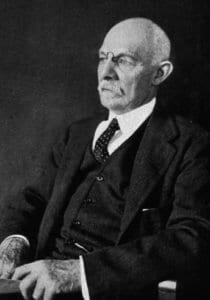
One of the greatest early American surgeons and one of the “big four” founders of the John Hopkins Medical School faculty, William Halsted was a curious personality, a loner and egomaniac recluse, aristocrat in his breeding, touchy and sharp tongued, an advocate of precision who had little interest in private practice and spent his life avoiding patients and rather work out the problems of clinical surgery. Born in New York City in 1852 and graduating from Yale medical school in 1877, he held appointments in New York Bellevue Hospital and spent some time in Europe learning from prominent surgeons and scientists. In 1882 he performed the first gallbladder operation in the United States by operating on his mother on the kitchen table in the middle of the night to remove seven gallstones. He also performed the first blood transfusion in the United States.
In 1884 he read how an Austrian ophthalmologist Carl Kohler used cocaine as an anesthetic. He began using it on patients, but also experimented on himself, becoming addicted to it and repeatedly requiring detoxification. Later he also became addicted to morphine. In the operating room he noted how a young nurse, Caroline Hampton, was wearing rubber gloves because she was sensitive to the strong local antiseptics used, and he began to use such gloves himself while operating (and later married her). Rubber gloves could sterilized more completely than the surgeon’s hand, and their use by Halsted was the beginning of a career in which he emphasized meticulous surgery characterized by perfect cleanliness, infinite gentleness and patience in handling tissues, never hurting them and disturbing them as little as possible, and showing that healthy tissue could conquer bacteria and heal more easily than tissue damaged by rough handling. With his new methods he extended the range of his operations, repairing aneurysms and inventing new ways of tying them off, introducing radical mastectomy for breast cancer, and new techniques for repairing hernias and operating on the thyroid, biliary tract, and intestine. He introduced the use of anesthetics, local and general. He never formally taught but nevertheless was a superb role model inspiring young men such as Harvey Cushing to became some of the great surgeons of American life.

Leave a Reply